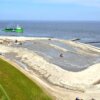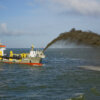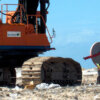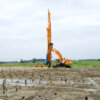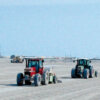Hydraulic fill is material that is dredged from a borrow area or other area and placed at a site to raise the level of the land or build new land.
Hydraulic fill can be won from designated borrow areas or from riverbeds, seabeds or oceans. The quality and quantity of this fill is of the utmost importance in planning a dredging project.
Quality of hydraulic fill
The quality of hydraulic fill is determined by its behaviour after dredging, the transport of the fill, and its deposition at the site it will be used.
The quality is evaluated after deposition by its stiffness and strength of the mass. These mass properties are influenced by properties like
- mineralogy;
- grain shape;
- angularity; and
- particle size.
Quartz sand
Loose, medium grained quartz sand is considered to be the most suitable fill material for reclamation purposes. Of course, suitable quartz sands are not always available and so the choice of materials under certain circumstances may vary.
Alternative fill
Given geographic and environmental restrictions, hydraulic fill may also be acceptable from other capital or maintenance dredging projects. In these cases, even more thorough testing and investigation of materials is required. These alternative fill materials can be clay, carbonate sand or rock. These materials may have different mass properties which can be addressed and still made usable.
Quantity of hydraulic fill
The quantity of fill available is described as the in-situ volume of extractable material that is suitable within the boundaries of the borrow area. It is important to note that the volume of the material extracted may change as a result of losses of fine material or bulking, which is a change in density.
Other factors that affect the extractable quantity of fill are the difference between the top and bottom of the suitable deposits and the allowable slope angles of the borrow pit. These slope angles may be restricted because of stability issues or because of other limitations in the surrounding areas like the safety of buildings in the vicinity.
related
Articles
Land reclamation: The potential for subsurface freshwater storage

At present too little use is made of the opportunities that the design and construction of land reclamation offer for the underground storage and recovery of fresh water. The managed aquifer recharge systems in the coastal dunes of the Netherlands are a good example of successful subsurface water storage. And it is to be expected that the sandy deposits of land reclamations could serve a similar purpose. This in turn will contribute to a sustainable development of land reclamations.






